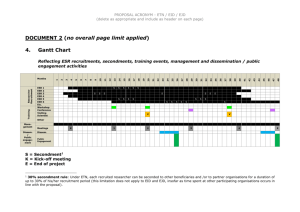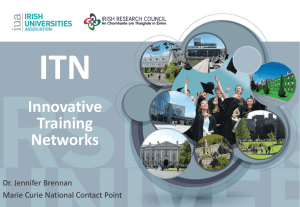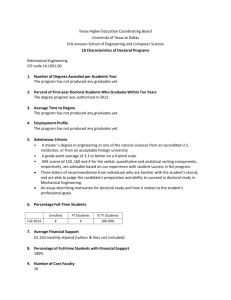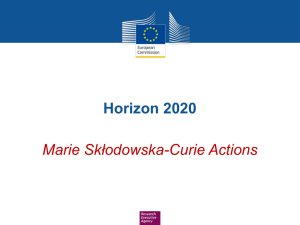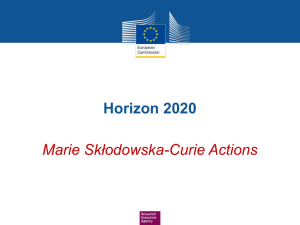Non-academic sector
advertisement
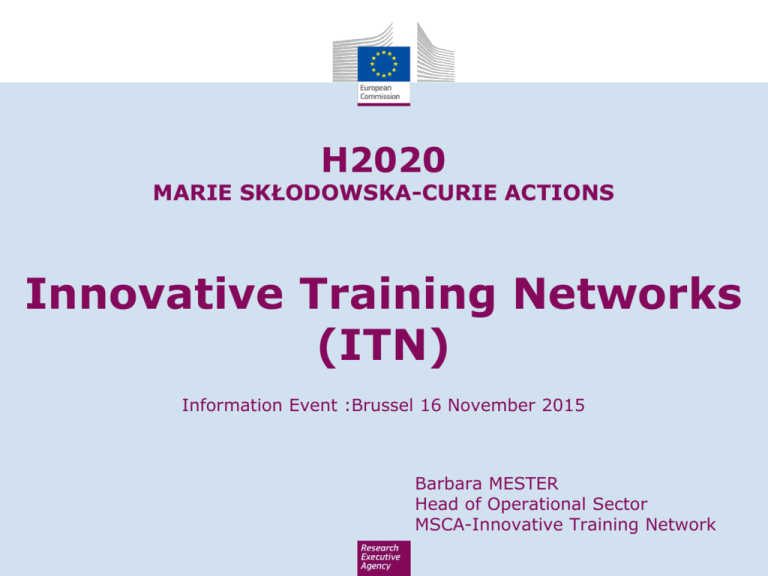
H2020 MARIE SKŁODOWSKA-CURIE ACTIONS Innovative Training Networks (ITN) Information Event :Brussel 16 November 2015 Barbara MESTER Head of Operational Sector MSCA-Innovative Training Network Contents 1. What are ITNs? • ETN • EID • EJD 2. Evaluation Criteria 3. Ethics 4. Evaluation 5. Tricks and Tips Information? Application? Participant Portal H2020-MSCA-ITN-2016 Work Programme (WP) Guide for Applicants (GfA) FAQs http://ec.europa.eu/research/participants/portal/desktop/ en/opportunities/h2020/topics/2056-msca-itn-2016.html What are ITNs? Excellent science European Research Council € 13.1 B Marie-Skłodowska-Curie Actions (MSCA) € 6.1 B Future and Emerging Technologies € 2.7 B European research infrastructures (including eInfrastructures) € 2.5 B ITN Objectives • Train innovative and entrepreneurial early-stage researchers • Raise excellence and structure in doctoral/early-stage research training • Provide skills relevant for innovation and long term employability • Improved career perspectives of researchers through international, interdisciplinary, intersectoral mobility • Attractive working and employment conditions. • Collaboration between academic and non-academic sectors ITN implementation modes ETN EID European Training Networks European Industrial Doctorates EJD European Joint Doctorates Participants implement a joint research programme Doctoral training with the non-academic sector Doctoral programme to deliver joint degrees 317 M€ 25 M€ 28 M€ ~93 projects ~20 projects Research fields chosen freely by applicants (CHE, ECO, ENG, ENV, LIF, MAT, PHY, SOC) ~8 projects Common Features Activities International networks of organisations Joint research training / doctoral programme* Keywords: Inter-nationality Inter-sectorality Inter-disciplinarity *any scientific domain except areas of research covered by the EURATOM Treaty Common Features Activities Individual research projects embedded in an overall project Structured training courses lectures, turorials.. Exchanges of knowledge within network and exposure to non-academic sector visits and secondments Network–wide training activities interdisciplinar/intersectoral seminars, workshops, summer schools … Training in transferable skills entrepreneurship, management, IPR, communication, ethics, grant writing Common Features Quality supervision and career guidance Communication & Dissemination Public engagement Open Access (Open Research Data) Supervisory board Consortium Agreement Duration of normally 48 months ESR support between 3 and 36 months Trans-national mobility Open Access Publications Peer-reviewed publications must be deposited in open access repositories = Free of charge on-line access Data Optional "Data Management Pilot": If option is chosen, the proposal must contain a data management plan: http://ec.europa.eu/research/participants/data/ref/h2020/grant s_manual/hi/oa_pilot/h2020-hi-oa-data-mgt_en.pdf ESR: Only Early-Stage Researchers (ESRs): ≤ 4 years of research experience no PhD yet Mobility Rule But no restrictions based on nationality • No main activity in country of host organisation for more than 12 months in the 3 years immediately prior to (first) recruitment. • Compulsory national service and/or short stays such as holidays are not taken into account. • IF international organisations: no main activity for more than 12 months in the 3 years immediately prior to recruitment at the same organisation. mobility calculated at date of recruitment! Consortium Who can apply ? International networks of organisations Two categories of organisations Academic sector public /private higher education establishments awarding academic degrees public /private non-profit research organisations whose primary mission is to pursue research international European interest organisations (e.g. CERN, EMBL) Non-academic sector any entity not included in the academic sector: e.g. large companies, SMEs, NGOs, museums, hospitals international organisations (e.g. UN, WHO) Standardised legal validation of entities is applied to determine the category of each participant Consortium Roles ? Partner Beneficiary vs. Organisation Signs grant agreement Recruits and hosts researchers * Claims costs to the EU Trains/hosts seconded researchers Participates in supervisory board * Flexible recruitment in EID and EJD: an organisation may participate as a beneficiary without recruiting Consortium Operational Capacity Participants must have adequate operational capacity to carry out the assigned tasks. The aim is to exclude applicants with clearly inadequate infrastructure / resources / supervision capacity Do all beneficiaries have: appropriate premises to host researchers? appropriate staff resources to supervise/train researchers? Where to provide information: Table on "data for non-academic beneficiaries" (Part B, 1st page). Table on "participating organisations" (Part B5). European Training Networks (ETN) ETN Participants implement a joint research training programme Beneficiaries Partner organisations ETN Participants implement a joint research training programme Mandatory Minimum 3 beneficiaries from 3 different MS/AC Each beneficiary recruits and hosts at least 1 ESR Max 540 person-months (e.g. 15 ESRs x 36 months) Max 40% budget to one country Other features Non-academic participation essential PhD enrolment typically expected (not mandatory) Secondments to other countries/sector/disciplines (≤30% time) Joint supervision recommended Partner organisations (any country/sector) Recommended size of consortium 6-10 beneficiaries European Industrial Doctorates (EID) EID Doctoral training with the non-academic sector NON ACADEMIC SECTOR ≥ 50% time for each ESR Beneficiaries Partner organisations 2 beneficiaries: max 180 PM EID Doctoral training with the non-academic sector NON ACADEMIC SECTOR ≥ 50% time for each ESR Beneficiaries Partner organisations ≥3 beneficiaries: max 540 PM EID Doctoral training with the non-academic sector Mandatory Minimum 2 beneficiaries from 2 different MS/AC 1 academic + 1 non-academic (+ degree-awarding as partner org.) Max 180 person-months (if 2 organisations) - e.g. 5 x 36 months Max 540 person-months (if ≥3 organisations) - e.g. 15 x 36 months Each ESR enrolled in a PhD Each ESR is ≥ 50% time in non-academic sector (intl. dimension) Joint selection, training and supervision (1 supervisor/sector) Other features Individual research projects under the topic of the doctoral programme Secondments above 50% rule (up to 30% of time) Partner organisations (any country/sector) Flexible recruitment rule Typical size is 2-3 beneficiaries European Joint Doctorates (EJD) EJD Universities cooperating to deliver joint/multiple doctoral degrees Joint PhD Joint PhD Joint PhD Beneficiaries Partner organisations EJD Universities cooperating to deliver joint/multiple doctoral degrees Joint PhD Joint PhD Joint PhD Beneficiaries Joint PhD Partner organisations EJD Universities cooperating to deliver joint/multiple doctoral degrees Mandatory Minimum 3 beneficiaries from academic sector awarding PhDs, from 3 different MS/AC Each ESR enrolled in the joint doctoral programme Joint selection, training and supervision Commitment to deliver joint/double/multi degrees Max 540 person-months (e.g. 15 ESRs x 36 months) Other features Meaningful stays at joint doctorate beneficiaries Non-academic participation through secondments to other sector/disciplines (≤ 30%) Flexible recruitment rule Typical size 4-8 beneficiaries EJD Joint PhD Universities cooperating to deliver joint/multiple doctoral degrees Joint degree: single diploma issued by at least 2 academic institutions, and recognised officially Double/multiple degree: 2 or more separate national diplomas issued by two or more higher education institutions and recognised officially Letters of institutional commitment to deliver degrees are required in the proposal Beneficiaries Person-months ETN EID EJD ≥3 from 3 diff. MS/AC ≥2 from 2 diff. MS/AC: (≥1 acad. award. PhD + ≥1 non-academic) ≥3 (acad. award PhD) from 3 diff. MS/AC Max. 540 Max. 180 / 540 Max. 540 Researchers ESRs only (3-36 months) Partner Org. Unlimited (any country / sector / discipline) PhD enrolment Expected mandatory mandatory Non-academic participation essential mandatory essential possible through secondments ≥50% in non-academic possible through secondments 8 panels: CHE, ECO, ENG, EID panel (25M€) EJD panel (28M€) Inter-sectoral exposure Panels and rank lists ENV, LIF, MAT, PHY, SOC (317M€) Evaluation Criteria Overview of evaluation criteria Threshold Weight Priority if ex-aequo Excellence n/a 50% 1 Impact n/a 30% 2 Implementation n/a 20% 3 Award Criterion Total 70% 1. EXCELLENCE Quality, innovative aspects and credibility of the research programme (including inter/multidisciplinary and intersectoral aspects) Quality and innovative aspects of the training programme (including transferable skills, inter/multidisciplinary and intersectoral aspects) Quality of the supervision (including mandatory joint supervision for EID and EJD projects) Quality of the proposed interaction between the participating organisations 2. IMPACT Enhancing research- and innovation-related human resources, skills, and working conditions to realise the potential of individuals and to provide new career perspectives Contribution to structuring doctoral/early-stage research training at the European level and to strengthening European innovation capacity, including the potential for: a) meaningful contribution of the non-academic sector to the doctoral/research training, as appropriate to the implementation mode and research field b) developing sustainable joint doctoral degree structures (for EJD projects only) Effectiveness of the proposed measures for communication and dissemination of results 3. IMPLEMENTATION Overall coherence and effectiveness of the work plan, including appropriateness of the allocation of tasks and resources (including awarding of the doctoral degrees for EID and EJD projects) Appropriateness of the management structures and procedures, including quality management and risk management (with a mandatory joint governing structure for EID and EJD projects) Appropriateness of the infrastructure of the participating organisations Competences, experience and complementarity of the participating organisations and their commitment to the programme Ethical Issues Ethics Issues Proposals must indicate: potential ethical issues How they will be handled Horizon 2020: How to Complete Your Ethics Self-Assessment http://ec.europa.eu/research/participants/data/ref/h2020/grants_manual/hi/e thics/h2020_hi_ethics-self-assess_en.pdf Ethics Issues Scientific Integrity Principles of scientific integrity must be respected Plan in proposal "Implementation") for dealing with scientific misconduct (under European Code of Conduct for Research Integrity http://www.esf.org/fileadmin/Public_documents/Publications/Code_Conduct _ResearchIntegrity.pdf Evaluation Overview of evaluation process Proposal Expert Expert Expert Eligible proposal Expert 4 experts Individual Evaluation Report Individual Evaluation Report Individual Evaluation Report Consensus group Consensus Report Individual Evaluation Report Individual evaluation Consensus Central Panel Review Schedule Publication Deadline for submission Information to applicants Indicative date for GA 15 October 2015 12 January 2015 at17:00:00 BXL time June 2016 September 2016 Tricks and Tips Tricks and Tips Proposal should be coherent Remember: No Negotiation Phase! "Go / No Go" Evaluation Read and follow WP and Guide for Applicants Meet as many requirements as possible, if not explain why Follow carefully the templates provided and check consistency Respect PAGE LIMITS Check Operational capacity Resubmission (year and acronym) – 2 previous years (2014 & 2015) Ensure clear and detailed scientific deliverables/milestones to allow progress assessment Thank you

